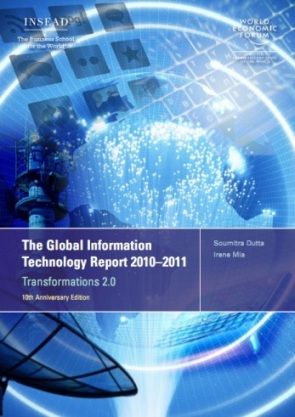Notes from the 2010-2011 Global Information Technology Report
The Global Information Technology Report presents data by variable and for 138 economies. Organized into nine robust sections, which correspond to the nine pillars of the Networked Readiness Index (NRI), the 10mb/400+ page report can take some time to sift through and digest. African sections of interest are cited and summarized below for your convenience. The takeaways should be that although African nations lag the global means of networked readiness, many nations show a glimmer of hope across at least a couple of sub-categories. Additionally, in many cases, African nations do not lag the global mean by far, especially in terms of government readiness (ie. Uganda may not have a good infrastructure or market environment, but the nation has a relatively better regulatory environment).
Sub-Saharan Africa summary (pages 27-28):
Even though ICT penetration rates have soared in the region over recent years, boosted by mobile telephony, and many countries have started to leverage more and more ICT to improve efficiency and reach out more and more to citizens, sub-Saharan Africa does not seem to have progressed as much and as fast as other areas of the world. Underdeveloped infrastructure, inefficient markets, opaque regulatory environments, inadequate educational standards, and widespread poverty are powerful obstacles against a more extensive and efficient use of new technologies for increased development and prosperity in the region.”
Mauritius: conducive market and regulatory environment coupled with the country’s high level of interest and preparedness in using ICT. Infrastructure shows a margin for improvement and ICT usage is still far below international best practices, especially for the business sector and the government.
South Africa: fairly stable at 61st place overall, with notable strengths in the first-class quality of its market (25th) and regulatory (23rd) environments, along with a well-developed financial market (6th). On a less positive note, individual preparation and uptake of ICT remain very weak. This is attributable to its poor educational standards, notably in science and math, as well as to the very high access costs to ICT prevailing in the country.
Gambia, Senegal, Kenya, Namibia, Cape Verde: placed at 76th, 80th, 81st, 82nd, and 84th, respectively. Kenya and Namibia, in particular, strengthen their positions by nine and seven places since last year, with impressive 26- and 33-rank improvements in their ICT readiness.
Malawi (105th), Mozambique (106th), and Uganda (107th) post important improvements in their overall networked readiness since last year.
Mauritania (130th, 28 places down), Mali (120, 24 places down), Lesotho (121st, 14 places down), and Burkina Faso (122, 14 places down) are the most notable examples of nations who lose ground relative to the rest of the world.
Angola and Swaziland enter the rankings for the first time at a disappointing 133rd and 134th position, respectively.
Burundi and Chad, hold the final two spots and tend to rank at the bottom for most sub-pillars.
Macroscopic Trends (pages 35-41):
- Emerging economies are to be 50% of the global Internet economy by 2020
- GDP growth for emerging economics will be flat at 6% through 2015
- The consumer class in emerging economies will double from 2005-2020
- The number of Internet users in emerging economies surpassed the number in advanced economies around 2007
- Internet penetration curves for three types of Internet adopter: First and converging show logarithmic trend; belated (most of Africa) shows exponential
Sub-Pillars (pages 308-391):
- 1.03. Availability of latest technologies – Africa closer to mean, less drop-off relative to global
- 1.05. Burden of government regulation – Africa generally closer to mean
- 1.07. Total tax rate – extremely high in Burundi, The Gambia
- 1.09. Number of procedures to start a business – Uganda highest with 18
- 1.10. Freedom of the press – last place: Zimbabwe, then Libya
- 2.08. Software piracy rate – high in SSA
- 3.04. International Internet bandwidth – very low in SSA, non-existent in Chad, Burundi
- 3.06. Tertiary education enrollment rate – last place: Malawi 0.5%
- 4.01. Quality of math and science education – last place, by far: Angola
- 4.08. Fixed broadband Internet tariffs (monthly sub. charge (PPP $) – Malawi, Ethiopia, Swaziland are bottom three: $1,293-1,502
- 4.09. Buyer sophistication – low, but gradual drop-off from mean
- 5.08. Computer, communications, and other services imports – wide ranges: #2 Angola(!), #122 Burundi, #123 Lesotho, #126 Libya
- 6.-. Government readiness – not too far behind rest of world
- 7.02. Cellular subscriptions with data access – 14 African nations with none
- 7.03. Households with a personal computer – last place Ethiopia at 0.5%
- 7.04. Broadband Internet subscribers – 15 African nations with none
- 7.06. Internet access in schools – Drops off in Angola, Chad, Burundi
- 7.08. Impact of ICT on access to basic services – Africa closer to mean
- 8.03. Extent of business Internet use – Chad, Algeria lag rest
- 9.04. E-Participation Index – last place: Zambia with none
Source: The Global Information Technology Report 2010–2011. © 2011 World Economic Forum {http://www3.weforum.org/docs/WEF_GITR_Report_2011.pdf}













 Twitter
Twitter Facebook
Facebook Pinterest
Pinterest
[…] Readiness Index (NRI), which offers an overview of the current state of ICT readiness in the world. Last year, the report found that although African nations lagged the global mean of networked readiness, many […]